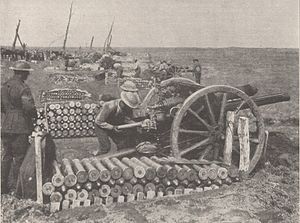Ordnance QF 18 pounder
| Ordnance QF 18 pounder | |
|---|---|

Australian gun crew in action in the Ypres sector, 28 September 1917
|
|
| Type | Field gun |
| Place of origin | United Kingdom |
| Service history | |
| In service | 1904–1945 (UK) |
| Used by |
British Empire Russian Empire Irish Free State Finland Estonia |
| Wars |
First World War Third Afghan War Russian Civil War Irish Civil War Waziristan 1936-37 Continuation War Second World War |
| Production history | |
| Designer |
Armstrong Whitworth Vickers Royal Arsenal |
| Designed | 1901 |
| Manufacturer |
Armstrong Whitworth |
| Produced | 1903–1940 |
| Number built | approx. 10,469 (Mk I & II) |
| Specifications | |
| Weight | 1.282 tonnes 2,825 lb (1,281 kg) |
| Barrel length | 7 ft 8 in (2.34 m) |
| Width | 6 ft 3 in (1.91 m) |
| Crew | 6 |
|
|
|
| Shell |
18.5 lb (8.4 kg) projectile |
| Calibre | 3.3in (83.8mm) |
| Recoil | 41 in (1.0 m) (Mk I - II); 26 in (0.66 m) to 48 in (1.2 m) (Mk III - V) |
| Carriage | pole trail (Mk I & II) box trail (Mk III & IV) split trail (Mk V) |
| Elevation | -5° to +16°(Mk I & II) +30° (Mk III) +37°(Mk IV & V) |
| Traverse | 4.5° left and right (Mk I - IV) 25° left and right (Mk V) |
| Rate of fire | 20 rpm (max); 4 rpm (sustained) |
| Muzzle velocity | 1,615 ft/s (492 m/s) (Mk I & II) 1,615 ft/s (492 m/s) (Mk IV) |
| Effective firing range | 6,525 yd (5,966 m) Mk I & II 7,800 yd (7,100 m) with trail dug in 9,300 yd (8,500 m) (Mk III, IV & V) 11,100 yd (10,100 m) (streamlined HE Shell Mk IC) |
Armstrong Whitworth
Woolwich Arsenal
Royal Ordnance Factory
Vickers
Beardmore
18.5 lb (8.4 kg) projectile
23 lb (10 kg) total including case.
Armour piercing
Smoke
Gas
Star
Incendiary
Shrapnel shell
The Ordnance QF 18 pounder, or simply 18-pounder Gun, was the standard British Empire field gun of the World War I era. It formed the backbone of the Royal Field Artillery during the war, and was produced in large numbers. It was used by British and Empire Forces in all the main theatres, and by British troops in Russia in 1919. Its calibre (84 mm) and shell weight were greater than those of the equivalent field guns in French (75 mm) and German (77 mm) service. It was generally horse drawn until mechanisation in the 1930s.
The first versions were introduced in 1904. Later versions remained in service with British forces until early 1942. During the interwar period, the 18-pounder formed the basis of early versions of the equally famous Ordnance QF 25 pounder, which would form the basis of the British artillery forces during and after World War II, in much the same fashion as the 18-pounder had during World War I.
During the Second Boer War, the British government realised that its field artillery was being overtaken by the more modern "quick firing" guns of other major powers, and investigated replacements for its existing field gun, the BL 15 pounder 7 cwt. In 1900, General Sir Henry Brackenbury, the then Director-General of Ordnance, sent officers to visit European gun makers. At Rheinische Metallwaren und Maschinenfabrik in Düsseldorf, they found a quick firing gun designed by Heinrich Ehrhardt with a recoil system that totally absorbed all the recoil of firing, 108 guns plus spares, were secretly purchased and entered service as the Ordnance QF 15 pounder in June 1901.
...
Wikipedia
